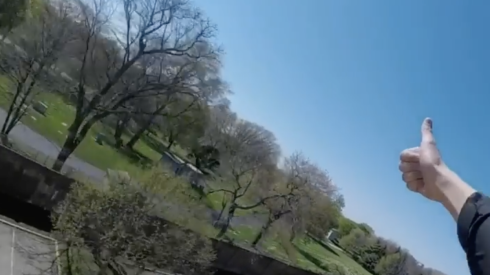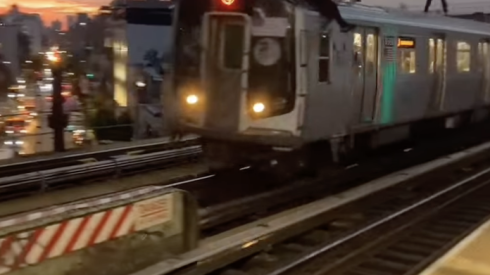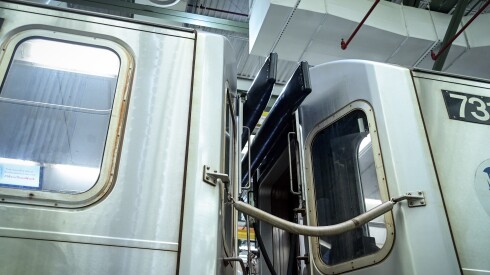A Chicago man who says he has “subway surfed” numerous times since he was a teenager — surreptitiously climbing atop moving L trains and becoming an open-air commuter, which he often chronicled on video and posted on social media — says there’s nothing else like it.
“The feeling that you get is one of the most insane feelings on earth because you’re putting yourself in a spot that’s not really natural,” according to the man, who asked not to be publicly identified.
“It’s the most freeing thing ever,” he said, comparing it to “an addiction.”
Which the CTA is hoping doesn’t spread, as occurred on the New York City transit system, where subway surfing has reached epidemic — and dangerous — proportions.
Nine people partaking in the high-stakes thrill-seeking in that city’s subways since last year have been killed, and police have made roughly 300 arrests, authorities say.
Nothing even close to that is happening in Chicago, but CTA records show train surfing is indeed occurring in Chicago, with 24 incidents logged since 2023 — though transit employees and others say the reckless behavior is surely occurring more than the records indicate.
No injuries have been reported, but the incidents have proven at times a nuisance for passengers who were delayed as a result, and for police and CTA employees who had to respond and cut power so nobody was electrocuted on the third rail pulsing with 600 volts to power the trains.
The records show surfers drawn to the West, South and North sides, with nine incidents so far this year, 12 in 2024 and three in 2023.
Six occurred on the Red Line — which spans from Howard Street in Rogers Park to 95th Street in the Roseland area — and six on the Brown Line.
There were four on the Green Line, three on the Blue Line, two on the Orange Line, two on the Purple Line and one on the Pink Line.
Only the CTA’s Yellow Line, which stretches from Howard Street to Skokie, reported none.
One of the more recent events occurred Aug. 24 around 4:30 p.m. in the Loop, with CTA records reporting there were “3 unknown male train surfers on the top of a Brown Line train southbound on the Wells Street Bridge,” and they “alighted the 3rd rail car #3456 and exited that station at Washington/Wells.”
Just a few days earlier, also in broad daylight, a “male wearing all black was sleeping on top of the 2nd rail car” on a southbound Red Line train near 47th Street.
“Operator 802 reports he instructed the offender to climb down off the train . . . no reports of any injuries and Operator 802 proceeded with a 3 minute delay.”
In June on the Blue Line near the Cicero stop, the motorman was notified by a rider there was a “male wearing black shorts only, no shirt, no shoes, on top of the train head car.”
“Power control was notified to remove power.”
The Green Line is attractive to surfers because, along certain stretches, “it’s fast — they do it for the thrill,” said a CTA employee who works the route, adding they also seem to do it “for social media, for the likes and views,” since there’s often video taken and posted online.
While he agrees that riding atop an L car is thrilling, and an opportunity for great social media posts that burnish reputations in the youthful world of graffiti and “underworld lifestyle,” the man who’s subway surfed in Chicago says he isn’t wowed by the speed factor.
“When I started train surfing I only did the Brown Line,” he said. Partly, that’s because he was familiar with it, “but also because it’s a slower speed,” which “gave the ability to stand and film at the same time.”
The man’s father was “super into street art and graffiti,” so that had an influence on the son even at a young age. While still a kid, he became drawn to YouTube videos about urban exploration and daring feats, and wanted “to get into the world of art and exploring . . . totally crazy s— but not anything that can hurt anyone.”
While in high school he began making his mark with graffiti, and created video montages about his exploits, which came to include train surfing.
He was increasingly drawn to it because of the “adrenaline” rush, and because it gave him “my own persona in this world,” and few others were doing it locally.
“I just wanted something different in my life, I needed a feeling of some power,” he said, adding that feeling was something he “couldn’t get through graffiti.”
Amid the pandemic, his interest took root more deeply. “It felt like people had the freedom to do whatever,” he said. “We were in lock down” and “didn’t know what was going to come next . . . so we were like, ‘We can f— do whatever we want.”
“It was such a crazy time . . . the energy was there, the time was right, it just blew up into this whole thing.”
Saying they didn’t want to glamorize or encourage the practice, CTA officials would not submit to an interview or provide many details about surfing incidents — or release video images.
Chicago police overseeing transit patrols likewise wouldn’t talk, except to say: “When reports of criminal activity are reported to CPD, we will work closely with CTA Safety and Security to identify and apprehend the involved individuals to hold them accountable.”
A motorman on the Red Line interviewed by the Chicago Sun-Times recalls a man last year riding L trains on the South Side.
He was “dressed in all black, he loved to climb up there,” according to the operator, who said he’d see the illicit rooftop commuter on a train he was passing from the other direction. “I’d hit the train horn and try calling” his counterpart on the other train.
In other instances in recent years, as the Red Line cuts a swath through the Dan Ryan Expressway, drivers on the highway have spotted surfers on trains and honked at the train operators to get their attention about the surfers, said Pennie McCoach, president and business agent of Amalgamated Transit Union Local 308, which represents CTA rail employees.
Referring to the popularity of such surfing in New York, McCoach said, “I can say here we have had some situations like that, but it’s not frequently.”
“I’m praying that it does not trickle down here to the Midwest and Chicago.”
That’s what happened in the 1970s as subway graffiti culture swept from New York to Chicago and beyond, creating a sense of fear and lawlessness on trains through rampant spray painting inside and outside of trains by gangs and street artists. Ultimately, transit systems cracked down and adopted policies of quick clean-ups to create a greater sense of security.
A Metra spokesman says, “Our transportation and police departments also cannot recall any instances of surfing on our trains.”
When thrill seekers are spotted these days atop L trains, often the operator slows the train to a halt, or heads to the closest L stop, and electricity is cut if the interloper heads onto the tracks. If they’re caught, there might be an arrest, or the offender simply may be shooed or escorted off CTA property, records show.
The employee from the Green Line said train operators are trained not to simply slam on the brakes, because if “you’re going 55 and you stop,” the person on top is “going to get hurt really bad.”
One distinction between New York and Chicago’s subway systems: The Big Apple has several hundred miles of below ground track, while Chicago has 11, and more than 200 miles of elevated track or at street level. That means the CTA’s trains are heavily exposed to the elements — with rain, cold and snow not exactly optimal for clinging to a jostling metal frame outdoors.
Things have gotten so bad on New York’s Metropolitan Transportation Authority that the agency launched a public awareness campaign called “Ride inside, stay alive.”
The NYPD — which defines surfing as “riding outside a train car,” not just on top, but also off the side and backs of rail cars — has deployed drones to catch subway surfers in the act.
At least one grieving parent, plus New York City’s government, have filed lawsuits against social media companies that helped popularize subway surfing videos, which the CTA tries to get taken offline when they’re spotted so as not to further the behavior, sources say.
CTA employees and others say that while rooftop subway surfing isn’t rampant, it’s probably happening more than the agency’s records reflect.
Even so, they say regular crime is a much larger problem, with reported crime soaring amid the pandemic and only recently seeming to subside — though the Red Line motorman described his runs as sometimes almost lawless: “I have carloads of people smoking dope and gambling.”
Of the main pressure points the Trump administration is applying to large U.S. cities that skew Democratic, federal officials have threatened to withhold funding if transit crime isn’t corralled.
The Chicago subway surfer interviewed by the Sun-Times says he gets to a train’s roof by opening the door between L cars and uses “the chains as stepping stools.”
But he says he has not surfed for a year and a half or more, cooling on the practice for a lot of reasons. There’s a greater sense of maturity, he said, and with a close friend dying — though not from subway surfing — he’s come to value life more and see how death can impact the survivors.
He had a couple of harrowing incidents, too, including one where he and several friends less experienced at the practice were spotted, and the L train was halted between stations, so they hopped off and ran along the tracks, trying to evade capture.
Another time he was hit unexpectedly by a tree branch while on a moving train, though luckily not hard enough to be knocked off.
Besides, the CTA’s surveillance seems to be getting more widespread and sophisticated, as the agency is “doing a lot more stuff with cameras.”
The man described the injuries and deaths from the craze in New York as “pretty sad — I was lucky enough to understand what I’m doing but I feel these kids doing it don’t really understand.”
He hopes it doesn’t take hold in that way in Chicago.








